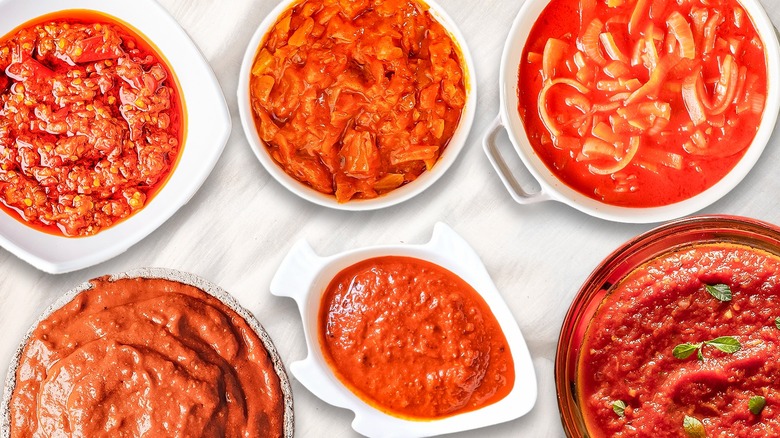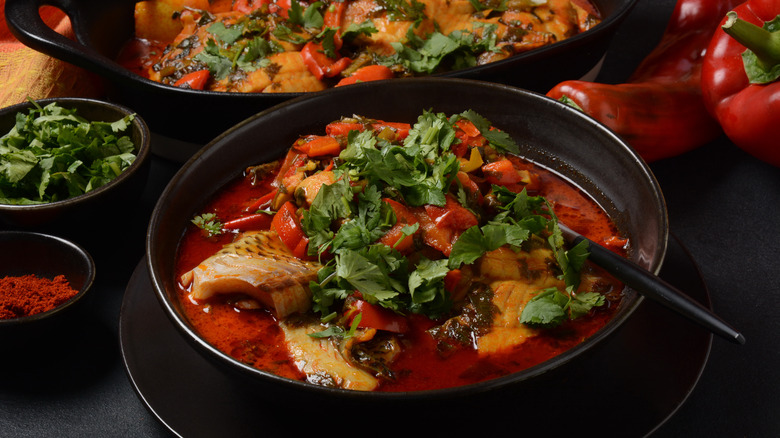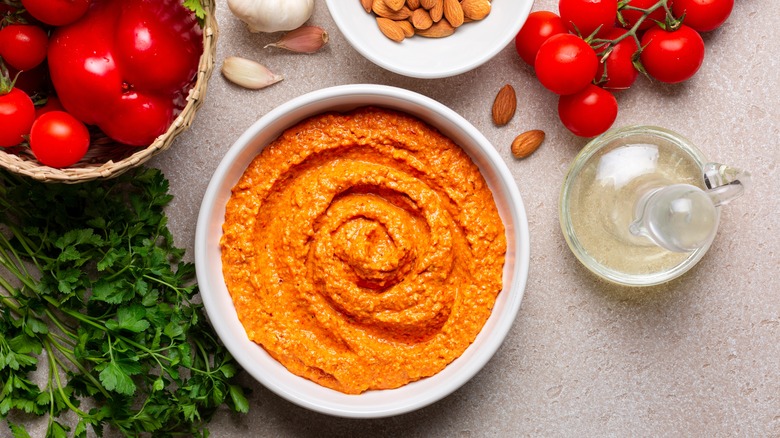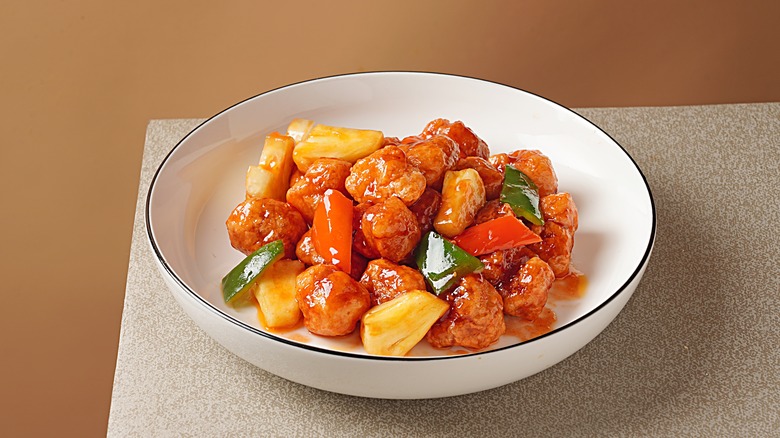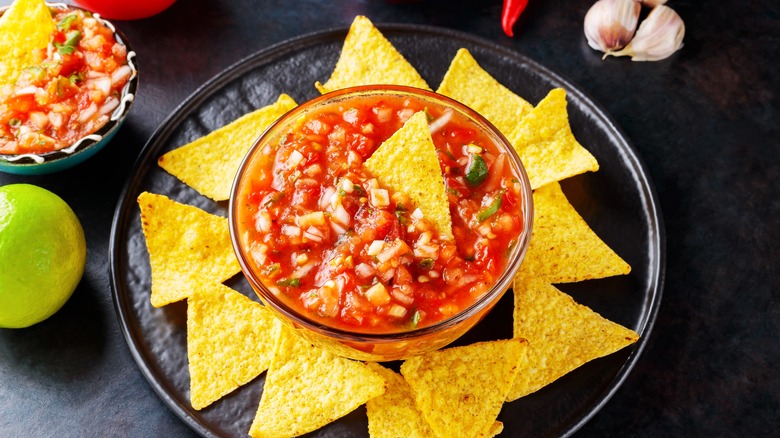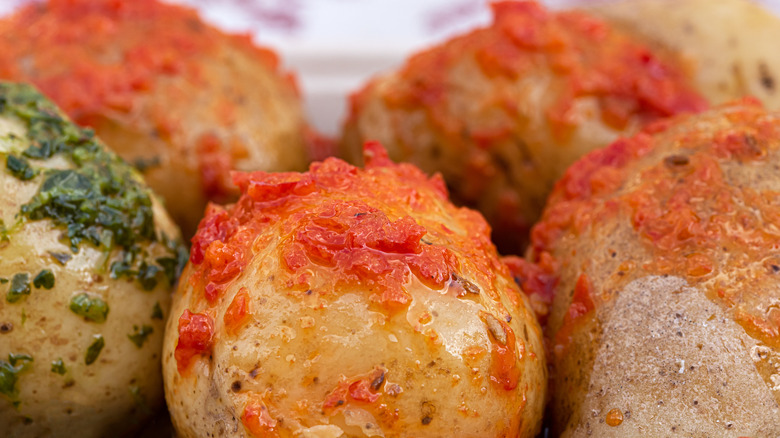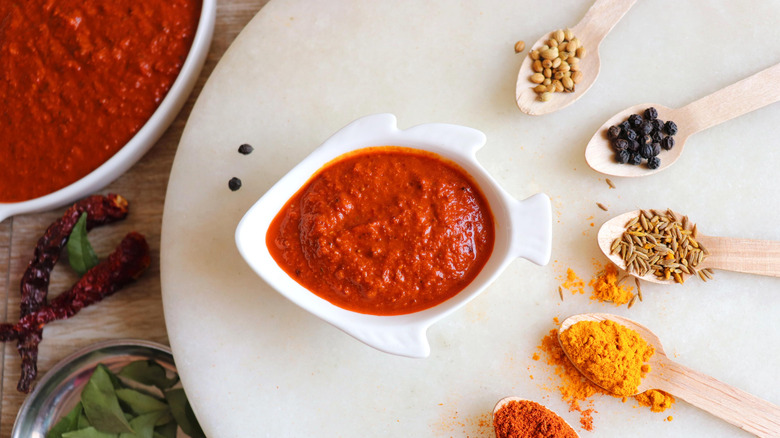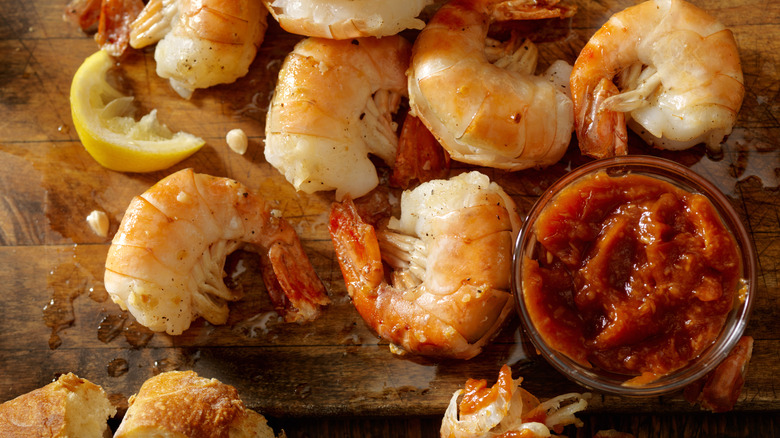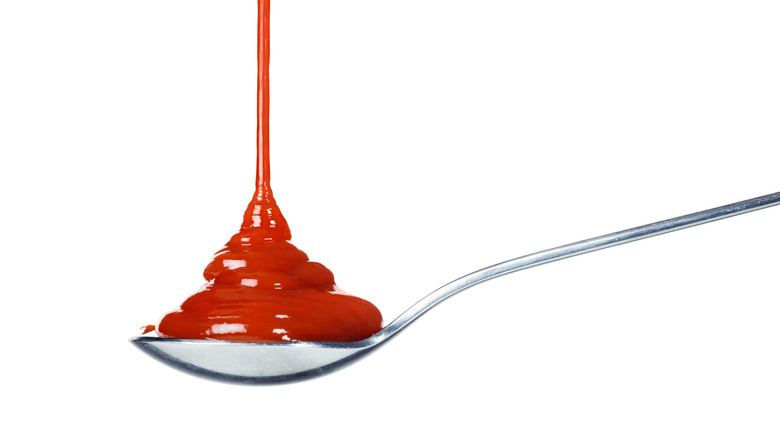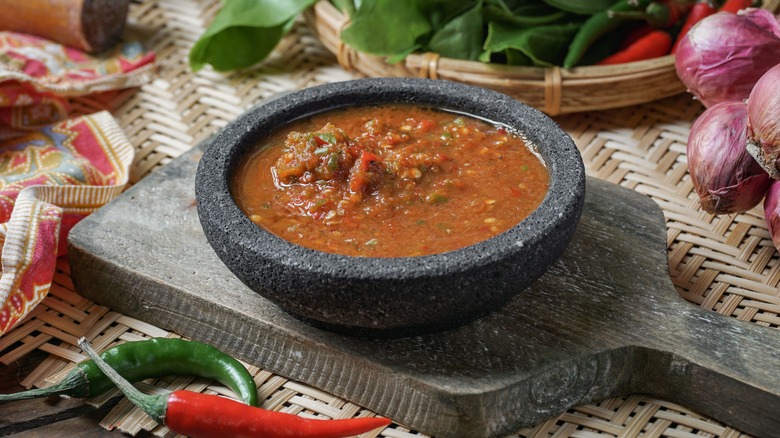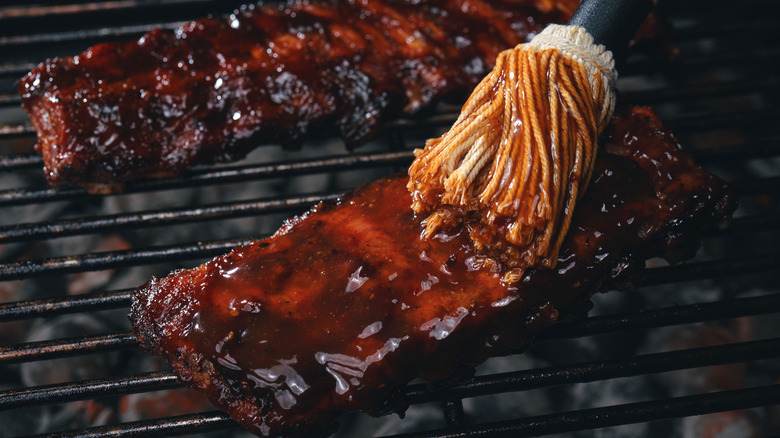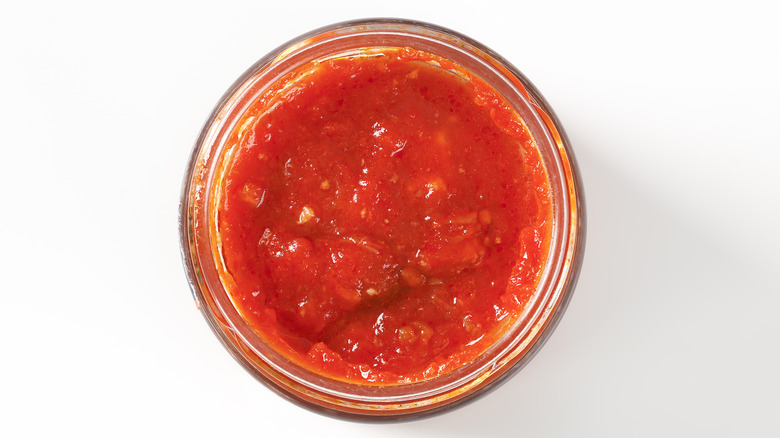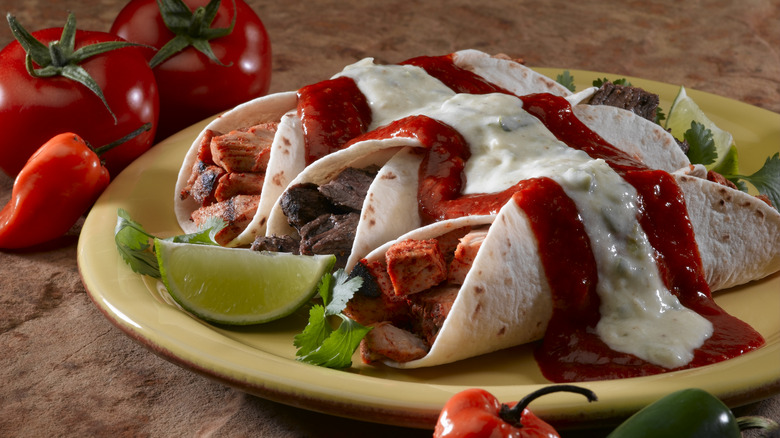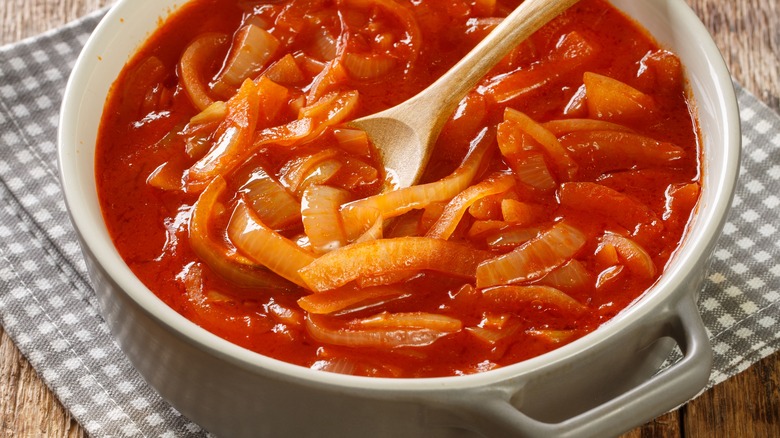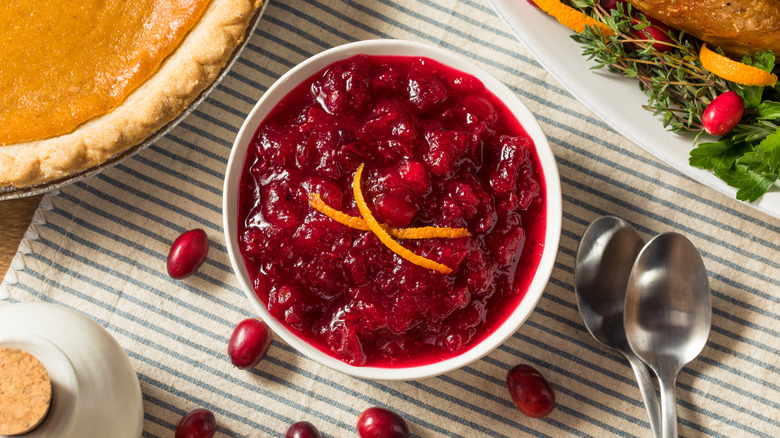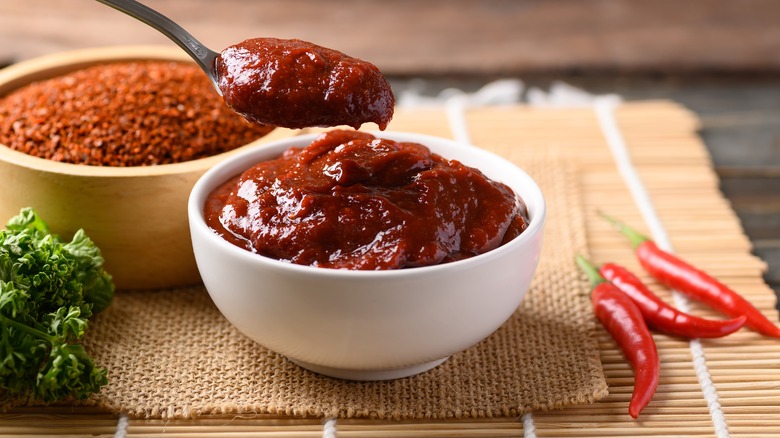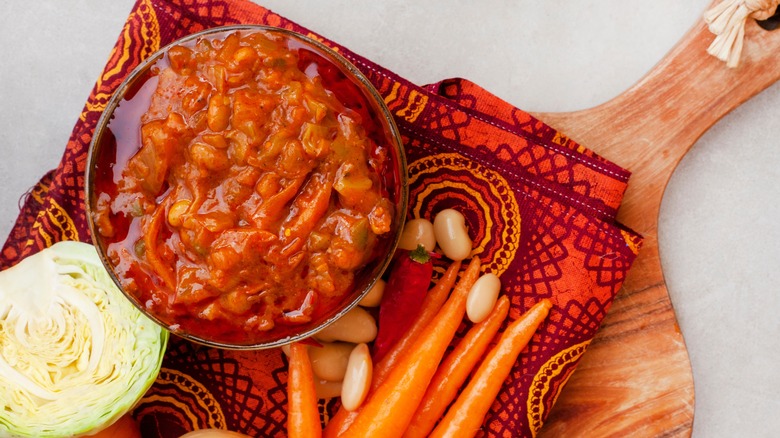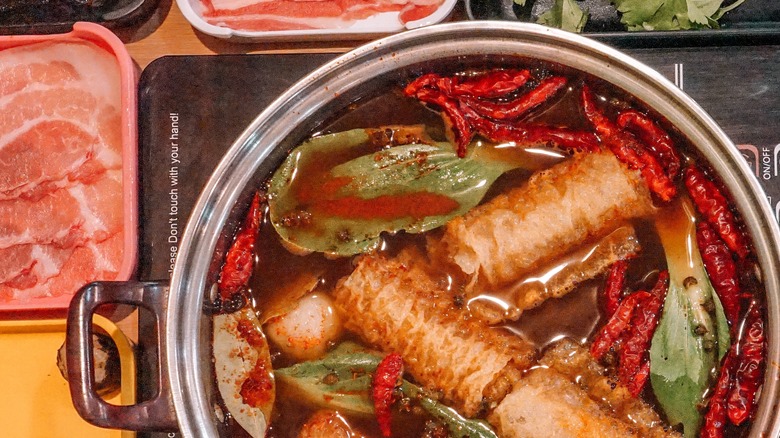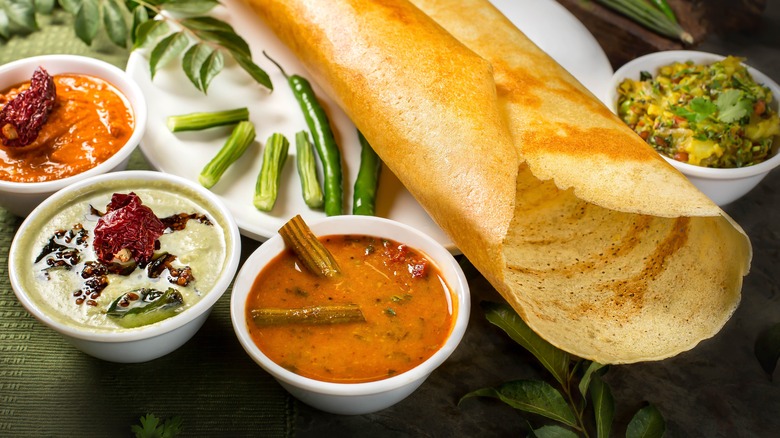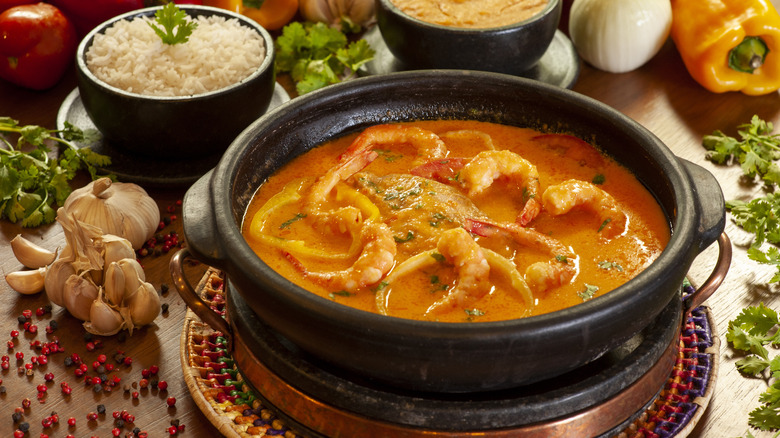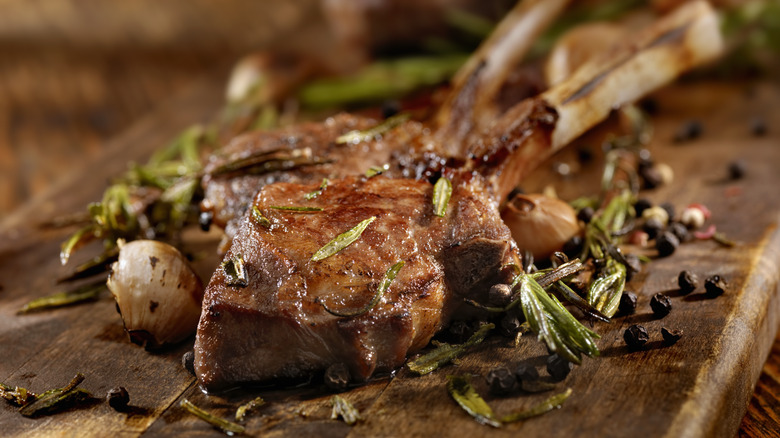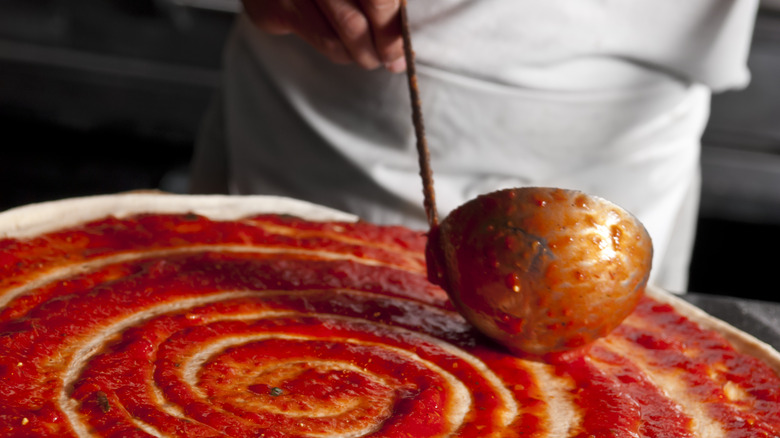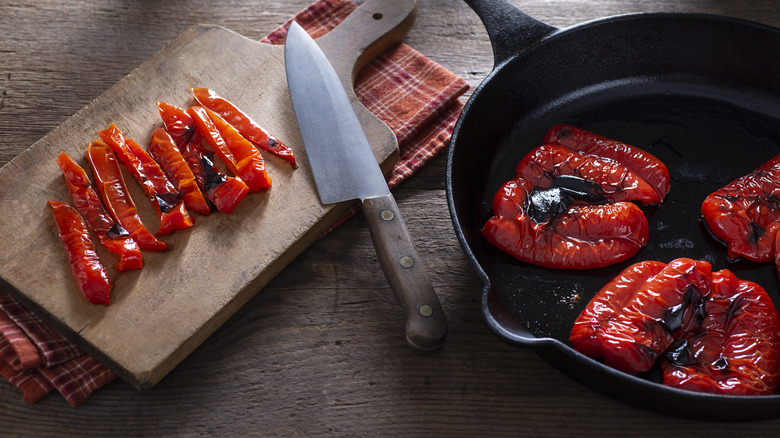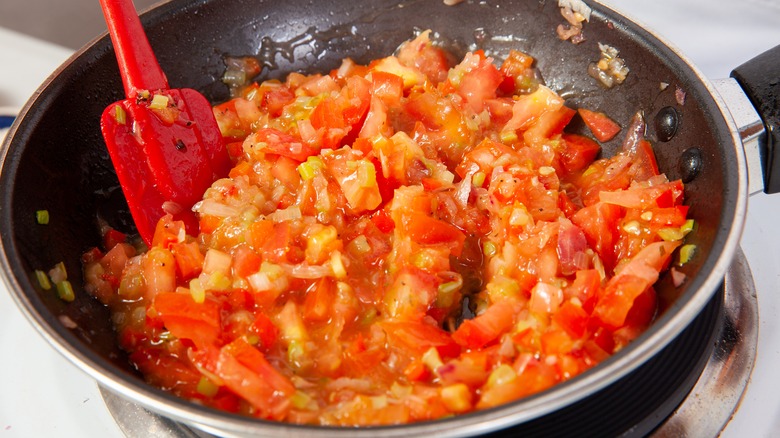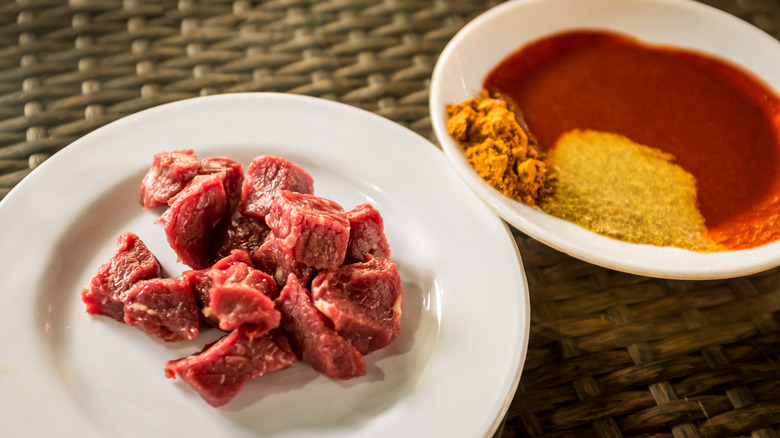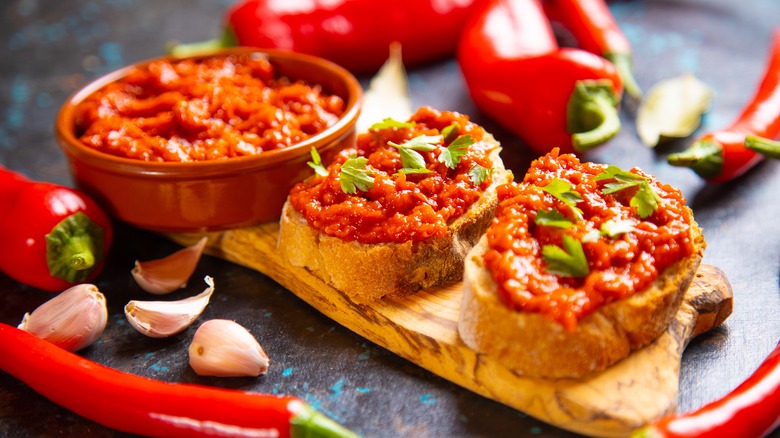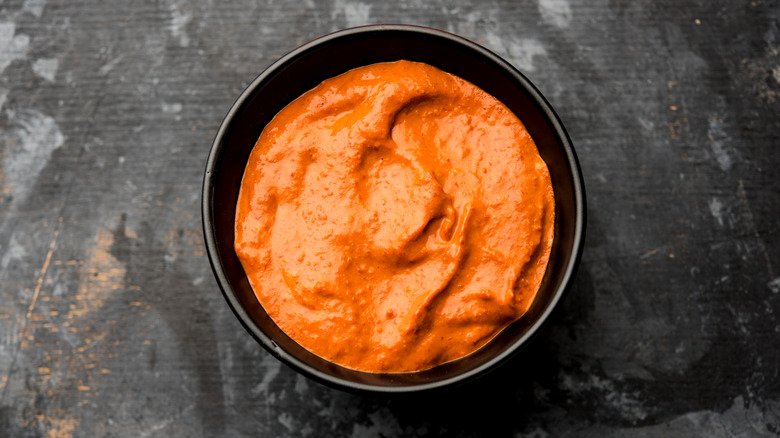26 Red Sauces From Around The World
When you think of traditional dishes from countries all over the world, you'll often notice that they are accompanied by equally traditional sauces, pastes, spreads, or dips. These condiments are often key parts of the meal, providing essential flavor and balance to everything else. While they come in many colors, you'll find that red sauces, in particular, are extremely widespread. These delicious sauces range from mild to spicy and feature local, easily accessible ingredients, although some of those ingredients may be harder to find outside of their country of origin.
Some of these international red sauces can be found in the supermarket, but certainly not all of them. Fortunately, traditional condiments are usually simple to make at home and taste better when you do so, too. Some are cooked, but many are mixed and eaten raw and require only a blender or a good knife. Whether you're marinating meat or vegetables, dressing grilled meat or fish, dipping bread, or elevating a legume stew, adding one of these characteristic red sauces will make a significant flavor difference. We've compiled a list of global red sauces that are worth trying at least once, though we think you'll be going back for more.
Chermoula
Chermoula is an aromatic Moroccan sauce made from traditional spices that can be found in red or green versions. The red version has more heat from the addition of harissa, a spicy North African chili sauce with a base of roasted red peppers, hot Baklouti peppers, and spices. These are ground in a mortar and pestle with garlic, herbs, olive oil, and aromatic spices such as cumin, coriander, and mint. Sometimes additional flavorful ingredients like ginger or lemon juice are added as well. The resulting sauce is used not just to marinate meat, fish, and vegetables, but also as a condiment for grilled meat or fish and as an ingredient in stews.
Romesco
Smoky Romesco sauce is a red pepper, tomato, onion, and nut sauce hailing from the Catalonia region of Northeastern Spain. Its origins are disputed, but it dates back at least to the 1500s. Local tradition says that fisherman used to grind the sauce in a mortar and pestle and use it to add flavor to their freshly caught fish. Romesco is a delicious mix of tangy, smoky, nutty, and sweet flavors. The recipe varies according to who's making it, but it generally includes roasted peppers, tomatoes, garlic, toasted nuts, vinegar, and olive oil. Use it to dress meat, fish, vegetables, and sandwiches, or follow Catalan tradition and serve it on grilled spring onions.
Sweet and sour sauce
Scientists speculate that we're programmed to like the sweet and sour flavor combination because when we ate rotten fruit in prehistorical times, a certain sweet-sour balance meant we were consuming helpful bacteria instead of toxic fungi. Many centuries later, restaurants in New York City's and San Francisco's Chinatowns followed older Chinese traditions by combining rice vinegar with honey or sugar to make a sauce that plays to our evolutionary preference. Follow this homemade sweet and sour sauce recipe to make it at home in less than 10 minutes without the preservatives of processed versions. Umami-rich soy sauce and ketchup are added to the sugar and vinegar for flavor, and the mixture is thickened with cornstarch. The sauce can be used to coat shrimp, chicken, tofu, or vegetables or as a dip for eggrolls or dumplings.
Salsa
Salsa is a quintessential Mexican sauce that can be put on or in anything from tacos to soup. While the word salsa just means sauce in Spanish, the kind of salsa we're talking about here is referred to as salsa de mesa, or table salsa, because it's used on food after it's served. These 14 types of salsa cover some of the most common salsa varieties. While some call for pickled vegetables or dried chilis, most of them simply use fresh tomatoes or tomatillos, chilis, herbs, and spices, and are very easy to make at home. The addition of these versatile salsas makes just about anything taste better.
Mojo
Canarian mojo sauces are spicy local sauces from the Canary Islands that dress up roasted or grilled meats, fish, and vegetables or are used as flavor-packed marinades. Mojo verde is a green version, but mojo rojo is made from red ingredients like red bell peppers, chili peppers, and smoked paprika, along with garlic, olive oil, cumin, vinegar, and salt. If you're a fan of heat, try slathering mojo picón on potatoes. This version of mojo, made with picón peppers and cayenne pepper, is traditionally served with papas arrugadas, which are small wrinkled and salted potatoes. You can make any mojo at home in 10 minutes with a mortar and pestle.
Red curry paste
Believe it or not, green, yellow, and red curries from Thailand share the same recipe. It's the variety of pepper that determines the final color of the sauce. Red curries feature dried red chili peppers along with other flavorful ingredients like cilantro, galangal, Kaffir lime, and ginger. Red curry paste is very versatile, and it's often accompanied by coconut milk, which helps balance out the heat. No matter the color, there's one ingredient you shouldn't skip in Thai curry paste: shrimp paste. To make this crucial ingredient, ground shrimp is fermented and salted, and the resulting paste adds an intense umami flavor that will elevate any dish.
Cocktail sauce
Cocktail sauce served with shrimp in a martini or cocktail glass has lent an elegant touch to parties since the early 20th century. It was originally paired with oysters, although now it's more commonly eaten with shrimp. Don't let that tradition limit you, as many enjoy it with crab cakes, chicken fingers, and even cheese. While you can make a quick and dirty version simply by mixing ketchup and horseradish, try following this simple classic cocktail sauce recipe that can be made in five minutes. You'll combine lemon juice and lemon zest with ketchup, horseradish, Worcestershire sauce, Tabasco, salt, and pepper for a delicious and versatile result.
Ketchup
While it may seem that there's nothing more American than ketchup, the surprising history of ketchup traces its origins to Southeast Asia in the 1600s. You won't find this on the ingredient list today, but it was originally made with fermented fish, which was popular in that part of the world. After ketchup made its way out of Asia, recipes for it began to align with local tastes, and it was eventually made with tomatoes, a bountiful crop in America. The flavor was changed again when vinegar and salt were added to make bottled ketchup more shelf-stable. Today, ketchup is found in 97% of American homes.
Sambal
Sambal or sambal oeleck is an Indonesian hot chili paste, and you may have seen bottles of it sold in American supermarkets packaged by Huy Fong Foods. But what really is sambal oeleck? The word oeleck comes from the Dutch ulek, which means mortar and pestle, as this spicy sauce was made by grinding chili peppers using this tool. While there are countless versions of homemade sambal depending on who's making it, it generally includes chili peppers, vinegar, and salt, and has a coarsely textured consistency from the hot pepper seeds that are included in the sauce. Sambal oeleck is used both as a condiment and as an ingredient mixed into other cooked dishes.
Barbecue sauce
Barbecue sauce is a condiment that's hard to miss at American cookouts, and the various smoky, sweet, tangy, and spicy versions each have their own fans. While you might not guess this when reaching for a bottle sitting on a modern supermarket shelf, barbecue sauce has a surprisingly long history. It is believed to have originated in Africa, where barbecued meat was dressed with lemon and lime, and a missionary recorded barbecued meat being cooked with lime juice and hot peppers in the French West Indies in 1698. A hundred years later, experiments in barbecue in the Southern United States led to the creation of mustard and vinegar sauces. The rest, as they say, is history.
Red pesto
The best-known variety of Italian pesto is pesto Genovese, a green, basil-packed sauce from the Northern region of Liguria. But not as many people are familiar with other versions of this salty, rich, and potent sauce. Pesto alla calabrese, or Calabrian pesto, is made with roasted red pepper and ricotta cheese, sometimes with the addition of sun-dried tomatoes and almonds or pine nuts. Another version is pesto alla siciliana, or Sicilian pesto, which features tomatoes and ricotta cheese. These are known as pesto rosso (red pesto) for their beautiful red color, which can lean towards orange depending on who's making them. They can be used anywhere you'd use pesto genovese: with pasta, as a sauce, or as a dip. Give them a try if you've only sampled the green variety — you won't be disappointed.
Enchilada sauce
Enchilada sauce is another well-known Mexican condiment. It's seen drenching, well, enchiladas, which are corn tortillas filled with meat, beans, or veggies. Typically, there are two versions of enchilada sauce: red and green, or salsa roja and salsa verde. Red enchilada sauce is made with tomatoes and chilies, which can include ancho, cascabel, or pasilla varieties. Don't miss these tips for making the best enchilada sauce. While sometimes you need the convenience of buying it premade from a store, making it at home is a great way to use high-quality ingredients and get purer, stronger flavors as well as the satisfaction and enjoyment of making something delicious from scratch.
Cebolada
Cebolada is a red sauce from Portugal featuring onions and tomatoes. The name comes from the Portuguese word cebola, which means onion. It's frequenly made in the summer when tomatoes are in season and abundant. The sauce includes other ingredients like red bell pepper, garlic, olive oil, white wine, and spices, which contribute to its characteristic Portuguese flavor. Cebolada is served with meat or baked with fish. It can be spooned over vegetables like potatoes or yams, and it's also delicious to eat straight. It's simple to make in under half an hour by sauteing the vegetables, spices, and other ingredients until tender and aromatic.
Cranberry sauce
What would Thanksgiving be without cranberry sauce? The history of cranberry sauce as a Thanksgiving staple is said to stretch back to the first Thanksgiving in 1621 for which Native Americans made an unsweetened version of this tangy staple. Credit goes to Amelia Simmons in 1796 for explaining in a cookbook called "American Cookery" that cranberry sauce (a sweetened version) tastes great with turkey. Canned cranberry sauce flies off the shelves in November because of the convenience of the ready-made dish, but you may find that making your own at home can be as simple as using only two ingredients.
Gochujang
Gochujang is a complex chili paste from Korea that can be put on almost everything. There's a lot to know about gochujang – the red color and heat level can vary depending on the chilies used, and there are countless varieties, which can be heavier on sweetness or saltiness. The sauce is made from chili peppers, fermented soybean powder, sweet rice flour, salt, and other ingredients. It's the fermentation that causes the ingredients to develop a deep, delicious umami flavor. This fermentation actually takes months or even years, but it's worth it. Including gochujang as in ingredient in sauces will add a flavor boost that's definitely worth trying.
Chakalaka
Chakalaka is a South African spicy tomato and onion dish. It originated in the townships of South Africa and is a sauce of longstanding popularity, which is served with grilled meat at barbecues. It's made with chili peppers, bell peppers, tomatoes, onions, oil, garlic, curry powder, salt, and pepper. Like most homemade sauces, it has many versions, with some people adding ginger, cabbage, or cilantro. It's delicious hot or cold, and besides dressing meat, it can be eaten with bread. Sometimes baked beans are added, and in this case, it can be served with a cornmeal mush called mealie pap, turning the whole combination into a balanced meal.
Mala sauce
Mala sauce is a Chinese hot sauce from the Sichuan province. The main ingredient is Sichuan peppers, which are harder to find in the U.S. than more readily available hot peppers like those from Mexico, but any kind of dried chili pepper will work. If you can get Sichuan peppers, they provoke a tingly feeling in your mouth when you eat them, and this actually gives it its name. In Chinese, Mala is two words, with ma meaning tingly and la meaning spicy. It can be used with a variety of dishes, from stir-fries to stews. This hot sauce is easy to make: Just grind chili peppers, salt, oil, and optional toasted sesame seeds in a mortar and pestle or a high-speed blender. It'll keep for a year.
Garlic chutney
If you've ever wondered about the three sauces commonly served with samosas, they are all different-colored versions of Indian chutneys. The red sauce is a garlic chutney, which is very spicy and has a vivid red color thanks to the large number of red chili peppers the recipe calls for. It also calls for garlic, cumin, sugar, and lemon juice or vinegar to balance the garlic. Despite the sugar, it's not a sweet sauce like the other chutneys because the hot peppers definitely take over. You can add oil to give it a longer shelf life, and it's quick and easy to make at home by combining all the ingredients in a blender.
Molho apimentado
Molho apimentado is a Brazilian hot sauce that's also called Malagueta hot sauce because it's made from Malagueta peppers, which are also known as bird's eye chilies. This sauce is widely used in Brazil, it's very spicy, and it goes with almost anything. You can make it as spicy as you like, or dial down the heat by using fewer peppers. To make it, you'll blend ingredients like red bell pepper, tomato, onion, chili peppers, and ginger in a food processor before transferring the mixture to a pan and heating it in oil for a few minutes to reduce it. Finish it with a sprinkling of fresh cilantro.
Shrewsbury sauce
Shrewsbury sauce is a classic English sauce said to have originated in the town of Shrewsbury in the county of Shropshire in the 1800s. It's commonly served with roast lamb, beef, or venison and has a rich flavor with pungent notes from Dijon mustard and Worcestershire sauce. Unlike many red sauces that are blended raw, this one is cooked and takes a bit more time to make, but it still comes together in 20 minutes. You'll boil red wine and beef broth together, while whisking flour into melted butter in another pan. Everything will be combined with Dijon, Worcestershire sauce, salt, and pepper, and simmered some more to thicken.
Marinara sauce
With so many types of pasta sauce out there, it can be hard to understand what makes each one unique. Marinara sauce is similar to tomato sauce, but it tends to be thinner and less complicated to prepare. The name comes from the Italian word for seafaring, because it's said that it was eaten at sea on long voyages. It's a simple sauce that's ideal for making pizza or for using as a dipping sauce for mozzarella sticks, because the lighter flavor won't overpower the other ingredients. It's a cooked sauce made from tomatoes, olive oil, garlic, and basil. Extra points if you use San Marzano tomatoes for a classic and delicious touch.
Muhammara
If you're a fan of hummus, roasted red peppers, or Middle-Eastern food in general and you've never tried muhammara, then you're in for a treat. Muhammara is a delicious dish that combines spicy, smoky, sweet, and tangy ingredients into a complex taste that's sure to win you over. This rustic Syrian dip comes from the city of Aleppo, but it's popular throughout the Middle-East and even in North America and Europe. Roasted red peppers are the principal ingredient. They're blended with walnuts, oil, garlic, and sometimes tomatoes. Other ingredients are added for more flavor, including Aleppo pepper, salt, cumin, and coriander.
Hogao
Hogao is a traditional Columbian red sauce that's also known as criollo sauce, or Creole sauce, as it's a classic example of the fusion between African-American and European cuisines in Colombia. This is a simple condiment or dipping sauce made from oil, tomatoes, and onion. Many similar versions exist across Latin America, although they're called by different names and are characterized by distinctive ingredients or methods of preparation. In the Colombian recipe, ripe tomatoes, onion, scallions, and garlic are simmered in oil on low for about half an hour to develop the flavor. It's served with arepas (round corn patties), rice, meat, and soup, among other dishes.
Awaze
Awaze is an Ethiopian red sauce that has a complex flavor despite the fact that it's very easy to make. It contains berbere seasoning, a spice blend commonly used in Ethiopian cooking, which contains spices such as chili pepper, ginger, coriander, cumin, cloves, and fenugreek, and is very spicy. The berbere is mixed with lemon juice, honey, water, and t'ej, a sweet honey wine. You may not be able to find t'ej in the US, but you could use wine, gin, or beer instead. This delicious, spicy, and complex sauce is served with grilled meats and stews and as a dipping sauce for raw meat, an Ethiopian tradition.
Ajvar
Ajvar, a condiment, dipping sauce, and spread made from roasted red peppers, has a history tangled in controversy as Serbians and North Macedonians have both taken credit for its origins. As it's popular over a vast area in the Balkans, there are many variations of this dish, but the basic recipe includes roasted peppers, vinegar, oil, and salt, which are blended and slowly cooked to reduce and develop the flavor. It's traditionally made with Kurtovska kapija red peppers, but red bell peppers can be substituted. How do you eat ajvar? It's commonly served with meat and cheese but is delicious wherever you would use a dip or spread.
Piri-piri
Piri-piri is an Afro-Portuguese hot sauce that packs a serious punch of spice and flavor. Unique piri-piri sauce was created by Portuguese settlers in East Africa, and was used by both the settlers and the locals, and was subsequently taken to Portugal when the settlers left. It's traditionally made with bird's eye chilis from Africa, which are extremely spicy. This chili paste contains red peppers which are roasted and blended with chili pepper, garlic, vinegar, and salt, as well as other ingredients like lemon, paprika, and oregano. The recipe can vary from region to region. It's most commonly eaten with chicken but can be used whenever a hot sauce is called for.
